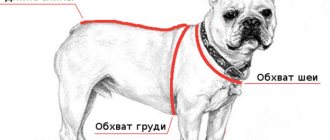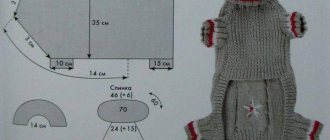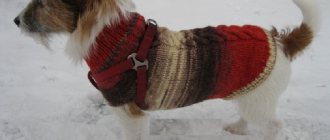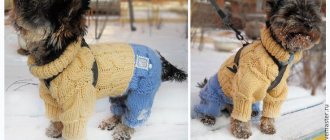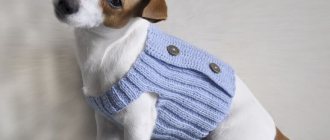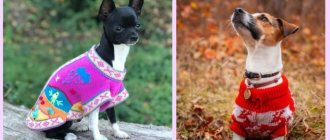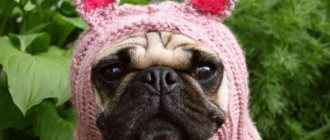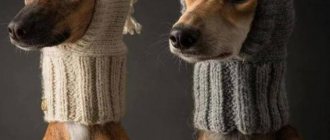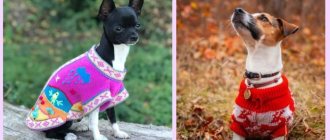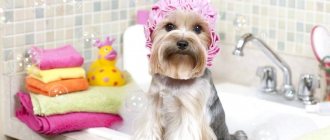Clothing for small dogs is not an attractive attribute, but a necessity. A dog of a hairless or toy breed will freeze in cool weather, and the desire to walk it longer will not help in achieving your goals. Today you can find many types of clothes for a small dog - overalls, blankets and others. All of them are expensive, and sellers do not always allow you to try on the intended purchase. I bring to your attention a knitted sweater for dogs that will please your pet and save the family budget.
Sweater with Norwegian pattern
Sizes: XS; S; M; L.
Chest circumference: 28-32; 40-44; 50-54; 60-66cm
Back length: 24-26; 32-34; 40-42; 48-52cm.
We will need:
- h/w yarn (50g per 100m), coffee color – 50; 100; 150; 200g; *same, white – 50; 50; 100; 100g; *same, chocolate color – 50; 50; 50; 100g; *set of toe knitting needles No. 3.5 – for size XS; *set of toe knitting needles No.3;
- circular knitting needles No. 3.
Patterns:
- persons Ch.: when knitting in the round, all sts in all rows are knitted, when knitting forward/reverse, we alternate r. persons p. with a row of purl;
- elastic band: 2l.x2i.
Patterns of the Norwegian pattern for knitting a sweater for a dog - see below.
Density: facial. Ch. 22p. for 30r. equal to 10 cm by 10 cm.
Description
Let's start knitting a sweater for a dog using sock knitting needles. We dial on sp. No3 coffee yarn 52; 76; 100; 124p. and knit in a round cut for 6; 8; 10; 12cm. Let's go to sp. No3.5 and knitting faces. Ch. In the first row of this pattern we add 8 stitches. at regular intervals. We get 60 in work; 84; 108; 132p. Next, for knitting, we use the Norwegian pattern patterns in the specified sequence:
- for solution XS: A-1; A-2; A-4;
- for solution S: A-1; A-2; A-3; A-4;
- for solution M: A-1; A-2; A-3; A-2; A-4;
- for solution L: A-1; A-2; A-3; A-2; A-3; A-4.
Instructions for making increases/decrements:
- when performing the last row of pattern A-1, add 5 at equal intervals; 7; 9; 11p. Total 65; 91; 117; 143p.;
- when performing the last r. scheme A-2 for dits XS and M we subtract 1 p., and for dits S and L we add 1 p. Total 64; 92; 116; 144p.
At height 4; 6; 9; 12 cm from the collar we divide the knitting: closed. 1p., transplant 11; 17; 23; 23p. on aux. sp. (we will knit the belly on these stitches), close. 1 stitch, on the remaining stitches we continue knitting the back according to the patterns. On 10; 14; 18; 22 cm we transfer these points to the auxiliary. knitting needle and return to working on the tummy. We knit it to a height equal to the back. Next, we connect both parts for general circular knitting, while in place of the previously decreased 2 stitches. we dial new 2p.
After completing the patterns, we continue working with coffee thread. At 15; 20; 25; 30cm closed for the tummy average 10; 14; 18; 22p. We continue to knit the back, closing on both sides in each 2 p.: 1; 3; 4; 6 times in 2 p., 9; 8; 9; 8 times 1 p., 1; 3; 4; 6 times in 2 p., 1 time in 3 p. Total 22; 32; 42; 52p. C 29; 38; 47; 52cm from the collar for knitting a sweater for a dog we use sp. No3.
We replant the p. on them and pick up the edges. row of loops. We get 84; 112; 144; 188p. We switch to circular knitting and perform 3; 6; 9; 12 rub. cutting with coffee yarn, 2p. with the same rice and chocolate yarn. Next R. closed P.
For the sleeves, we raise them along the edge of the armholes with knitting needles No. 3 36; 44; 52; 60p. coffee yarn and make 5; 8; 12; 17r. cutting Then we switch to the chocolate thread and knit another 2p. cutting Next R. closed P.
Knitting pattern
A sample (about 10-12 cm) is no small thing. We cast on loops on 2 knitting needles, then transfer them to 1 knitting needle, and use the 2nd knitting needle to knit the selected pattern. It is advisable to wash the sample, perhaps the yarn will shrink, then calculate the number of loops for the pet.
After all, it is this small detail that will help you accurately calculate the required number of loops for any part of the sweater.
Knit stitch - knit one row with only knit stitches, the next with purl stitches, then repeat the rows.
Front and back stitch
All this is done before the knitting stage.
Advice! It is advisable to outline a small plan and draw a pattern, recording all the measurements and converting everything into loops.
Melange sweater
Dog weight: 12-15kg.
We will need:
- melange yarn, composed of 77% acrylic, 20% wool, 3% polyamide (50g per 70m) – 150g;
- knitting needles No5 and No6.
Patterns:
- cutting: 2l.x2i.;
- persons Ch.: alternate p. persons p. with a row of purl.
Density: face. Ch. 12p. for 19 rub. will be 10cm by 10cm.
Description
Back
Using knitting needles No. 5, cast on 50 stitches. and knit 8p. cutting Let's go to sp. No6 and persons. Ch.
At an altitude of 36 rubles. (19 cm) on both sides we decrease the loops, retreating 2 stitches. from the edge: 2l., 2p. in 1 sheet, faces. to the extreme 4 p., 1 simple broach, 2 l. In 2 rubles repeat the decrease.
On the remaining 46p. let's continue working. Having knitted 58r. (30cm), move on to cutting with knitting needles No. 5. We knit 16 rubles. (this is 8cm) and closed. P.
Tummy
Using knitting needles No. 5, cast on 26 stitches. and do 8 rubles. cutting Let's go to sp. No6 and persons. Ch. From 36r. (19cm) on both sides we decrease by 1 stitch, as described for the back. We repeat the decrease through the row. There are 22 stitches left, on which we knit evenly. From 58r. (30 cm) using knitting needles No. 5, we knit a sweater for a dog using cut knitting. We knit 16 r. (8 cm) and close. P.
Mittens
Sp. No5 dial 26p. and knit 12 rubles in the round. (6cm) cutting. We do not close the loops. We knit the second sleeve in the same way.
Assembly
We sew the upper sections of the cutting. We sew the sleeves with a loop stitch. We make the side seams.
Pros and cons of knitted clothes
Hand-knitted clothing has these advantages:
- Matching the size of the pet.
- Natural materials.
- Softness and comfort.
- Convenience of knitted items: the yarn stretches and does not interfere with movements.
- Cheaper than purchased products.
- Originality and uniqueness of homemade accessories.
It is necessary to take into account the disadvantages of wardrobe items made from yarn:
- They stretch out during wear.
- The loops get caught easily and clothes can tear.
- They look unattractive over time: the color fades and pellets form.
- Requires careful handling when washing and drying.
Dressy sweater
Chest circumference: 25.5; 33; 40.5; 61; 76cm.
We will need:
- yarn, 100% acrylic (100g per 176m) – 100; 200; 200; 300; 400g;
- circular knitting needles No. 4 and No. 4.5;
- set of socks No4;
- markers (M).
Conventional abbreviations:
- P3L – cross 3p. to the left: remove 2p. on aux. sp. in front of the canvas, 1l., 2l. with aux. sp.;
- P3P – cross 3p. to the right: remove 1 p. on aux. sp. behind the canvas, 2l., 1l. with aux. sp.; *P4L – cross 4p. to the left: remove 2p. on aux. sp. in front of the canvas, 2l., 2l. with aux. sp.;
- P4P – cross 4p. to the right: remove 2p. on aux. sp. behind the canvas, 2l., 2l. with aux. sp.;
- P5P - cross 5p. to the right: remove 3p. on aux. sp. behind the canvas, 2l., 3l. with aux. sp.; *P3iL – cross 3p. from the wrong side to the left: remove 2p. on aux. sp. in front of the canvas, 1i., 2l. with aux. sp.; *P3iP – cross 3p. from the wrong side to the right: remove 1 p. on aux. sp. behind the canvas, 2l., 1i. with aux. sp.
Patterns:
- cutting: 2l.x2i.;
- double pearl pattern: 1p. (front): 1l., *1i., 1l.* – from * to * repeat on all sts; 2p.: 1i., *1l., 1i.* – from * to * repeat on all sts; 3p.: like 1p.; 4p.: like 1p.;
- pattern - diagram A: perform on 8p.: 1p. (fronts): 2l., 4i., 2l.; 2 rub. and all on the wrong side: according to the visible pattern; 3rd: P3L, P3P; 5r.: 8l.; 7r.: P3iL, P3iP; 9r., 11r., 13r.: 2i., 4l., 2i.; 15 rubles: P4P, P4L; 17r.: 8l.; 19 rubles: P3iP, P3iL; 20 rub.: according to risk. These 20 rubles. make up a vertical repeat of pattern A;
- pattern - diagram B: perform on 17p: 1p. (knits.): 5i., P3P, 1i., P3L, 5i.; 2l.: 5l., 3i., 1l., 3i., 5l.; 3r.: 4i., P3P, 1i., 1l., 1i., P3L, 4i.; 4r.: 4l., 3i., 1l., 1i., 1l., 3i., 4l.; 5r.: 3i., P3P, 1i., [1l., 1i.]x2, P3L, 3i.; 6r.: 3l., 3i., 1l., [1i., 1l.]x2, 3i., 3l.; 7r.: 2i., P3P, 1i., [1l., 1i.]x3, P3L, 2i.; 8r.: 2l., 3i., 1l., [1i., 1l.]x3, 3i., 2l.; 9p.: 2p., 2p., 1p., [1p., 1p.]x4, 2p., 2p.; 10r.: 2l., 2i., 1l., [1i., 1l.]x4, 2i., 2l.; 11r.: 2i., P3iL, 1i., [1l., 1i.]x3, P3iL, 2i.; 12r.: 3l., 2i., 1l., [1i., 1l.]x3, 2i., 3l.; 13r.: 3i., P3iL, 1i., [1l., 1i.]x2, P3iL, 3i.; 14r.: 4l., 2i., 1l., [1i., 1l.]x2, 2i., 4l.; 15r.: 4i., P3iL, 1i., 1l., 1i., P3iP, 4i.; 16r.: 5l., 2i., 1l., 1i., 1l., 2i., 5l.; 17r.: 5i., P3iL, 1i., P3iP, 5i.; 18r.: 6l., 2i., 1l., 2i., 6l.; 19r.: 6i., P3iL, 6i.; 20r.: 6l., 5i., 6l. These 20 rubles. form a vertical repeat of pattern B.
Density: on double pearl knot. 19p. for 28 rub. will be 10cm by 10cm.
Description
We start knitting a sweater for a dog with a set of sp. No4 42; 50; 62; 86; 102p. We cut at 7.5; 10; 10; 14; 14cm. In the last row we add 7 stitches at equal intervals. Total 49; 57; 69; 92; 109p. We set M, indicating the end of the river. and go to sp. No4.5. Next, the operating algorithm is as follows:
1r. (fronts): [1l., 1i.]x3; 5; 8; 14; 18 times, 2i., 8p. – сх. A, 17p. – sh.V, 8p. – сх. A, 2i., [1l., 1i.]x3; 5; 8; 14; 18 times. We knit further according to this distribution. At the same time, we knit the loops of the beginning and end of the row with a double pearl pattern, making additions of 1 stitch. in each 3; 5; 5; 9; 5 rubles, then every 2nd rub. before receiving
63; 77; 89; 129; 161p. We include the added items in double pearls. pattern.
From the next R. make slits for the paws: knitting 5; 5; 7; eleven; 12p. pattern, closed track. 4; 6; 6; 10; 12p., 45; 55; 63; 87; 113p. - according to the drawing, next. 4; 6; 6; 10; 12p. close, 5; 5; 7; eleven; 12p. - according to the figure.
Then we knit each part separately at 2.5; 4; 4; 6; 7.5cm height. Last r. - purl Next r. we connect the individual parts into a common fabric: knit 5; 5; 7; eleven; 12p. according to the pattern, over the previously closed points we dial 4; 6; 6; 10; 12p., 45; 55; 63; 87; 113p. – according to the pattern, dial 4; 6; 6; 10; 12p., finish according to the drawing.
It turned out to be 63; 77; 89; 129; 161p. We continue exactly at 11.5; 14; 18; 25.5; 28cm from M, ending purlwise. side by side. At the end of it we put the 2nd M.
At the beginning of the trail. two rubles closed 6; 7; 9; 12; 13p. and we get 51; 63; 71; 105; 135p. We continue according to the figure, making decreases on both sides in even rows. 1 p. before receiving 33; 43; 49; 73; 93p.
Next we knit the dog sweater at exactly 23; 29; 37; 51; 56 cm from the 1st M and transplant the item to the auxiliary. sp.
We make the front seam - from the neck to the 2nd M.
Sp. No4 we dial a circle. knitting needles along the edges of the faces. sides of one side 37; 40; 57; 73; 79p., starting from the 2nd M to the back loops, knit 33; 43; 49; 73; 93 sts of the back with knit stitches. At the same time we perform a decrease of 7p. on the back at equal intervals. Next we raise 37; 40; 57; 73; 79p. on the second side to the row with the 2nd M. There are 100 in total; 116; 156; 212; 244p.
We perform 2.5 cm of elastic bands in a circle. Closed P.
For the paws, we raise 8 along the edges of the openings; 8; 10; 12; 14p. on each side. Total 24; 28; 32; 36; 44p. on one paw. We knit in the round with a cut of 4; 5; 6; 7.5; 7.5 cm. Closed p. For the second paw, repeat as described.
How to take measurements
Before you start knitting, you should correctly take measurements from the animal. Things are selected based on indicators:
- Neck: girth at its base.
- Chest: Measure across the largest area of the chest.
- Back: fix the distance from the beginning of the neck to the tail.
- Step distance between paws.
- Paws - measure the length from the bone at the wrist of the leg to the chest or to the waist. These measurements are needed for sweaters, suits and overalls.
- The circumference of the head is calculated by the cheekbones and the wide area of the head - these are additional calculations for the hood.
Advice! It is necessary to take into account the breed and appearance of a particular animal.
Raglan sweater
We will need:
- yarn, consisting of 50% wool, 50% mohair - 50g each of melange and chocolate color;
- set of toe knitting needles No. 3;
- hook No.3;
- markers (M).
Patterns:
- persons Ch.: all loops in all rows. – facial;
- cutting: 2l.x2i.;
- cutting: 1l.x1i.;
- main pattern: 1p.: *2i., 2l. - the algorithm is as follows: we knit the second stitch behind the lower segment, then, without removing it from the sp., we knit the first stitch behind the upper segment, remove both loops, 2i., 3l. we shoot on aux. sp. before knitting, 3l., 3l. with aux. knitting needles* – from * to * repeat on all stitches of the row; 2 rub. (and all even): according to apparent risk; 3r., 5r.: *2i., 2l. (see algorithm for row 1), row 2, row 6* – from * to * repeat on all stitches of the row; 7r.: same as 1r.
Description of knitting a sweater for a dog
Along the length of the product during knitting we alternate color stripes: 2p. one color, 4 rub. – another. We start knitting a sweater with a set of melange yarn 52p. We switch to circular knitting and cut 2l.x2i. by 13cm.
The further distribution of stitches is as follows: 14p. – before, 1p. – raglan line (put M), 7p. – sleeve, 1p. – raglan line (put M), 20p. – back, 1p. – raglan line (put M), 7p. – sleeve, 1p. – raglan line (put M).
We move on to the main pattern, making 1 stitch increments in even rows. on both sides of each M. Having knitted 3 cm, remove the sleeve loops with a pin, and knit the front and back to 10 cm.
Then 18p. from the front side closed The rest - we knit in straight/reverse rows for another 10cm. Then all items are closed. We crochet the edge of the dog sweater with single crochets.
We transfer the sleeve loops to the joint. and knit faces with chocolate yarn. Ch. around by 6 cm, then another 3 cm with an elastic band of 1l.x1i.
Features of knitting a sweater for a dog on knitting needles
To create a sweater for a dog, you need to go through several steps:
Stage 1: taking measurements
When measuring, take into account that the “pet” will be active in the finished sweater and therefore immediately make adjustments of a few centimeters:
- product length (from collar to tail);
- width of the product (between the front and back paws);
- back and chest circumference;
- distance between paws;
- waist (abdomen) circumference;
- OL - paw circumference;
- ОШ - neck circumference.
How to take measurements from a dog
The peculiarity of a dog sweater is that the back is usually knitted wider and longer; especially for a dachshund, models need longer lengths. Let's walk through step by step for beginners how to properly knit a warm sweater for a dog with your own hands.
Knitting pattern for a sweater for a small dog
Important! All measurements presented should be taken when the dog is in a relaxed state.
Stage 2: gate
Based on the measurements, a set of loops is made and then the neck is knitted.
Where to start with a dog sweater
More often the collar is simply done with an elastic band.
Important! The neck for a dog is not made long so that it does not interfere with the “pet”.
Stage 3: Raglan
Product marking
The length of the raglan will depend on your measurements, as will all the details of this product.
Stage 4: sleeves
Knitting a collar and raglan
The loops for the sleeve will be closer to each other on the side of the front piece.
Stage 5: back/front
Ready sweater
After reaching the required length, you need to make an elastic band and close the loops.
Photo gallery
Photo 1. Toy terrier in a fur coat
Photo 2. Russian Toy Terrier in a leather jacket
Photo 3. Close-up of Toy in furs
We dress your pet
Of course, at first your dog may not be particularly enthusiastic about the need to dress . However, if you put on clothes right before going outside, the dog will quickly switch to the world around him and will not try to take anything off.
also remember that it is better to accustom your toy to clothes while still a puppy, from 3-4 months.
Overalls are the most common clothing for the Toy Terrier. Depending on the fabric, this can be either cute, light clothing for the summer that protects you from the sun’s rays—after all, the thin skin of toys burns just as easily as it gets frostbitten—or a warm, waterproof thing that will keep you safe from rain, snow, or another bad weather.
There are a wide variety of models - with a hood, with an additional warm lining, with special fasteners for boots so that the dog does not lose them. You can even sew fastenings and a ring for a leash into the overalls and use them instead of a harness.
We knit with our own hands
Before starting work, you need to knit a sample of the selected knitting, casting on 10 loops.
Having knitted 3 cm, measure the length of the resulting sample and calculate how many loops you need to cast on the finished product. Each model has its own instructions that belong only to it. We will indicate points that will be required for some models:
- each part of a sweater or vest can be knitted separately, followed by stitching, or it can be knitted in the round, without seams;
- can be knitted with sleeves (jackets, sweaters) and sleeveless (vests);
- experienced knitters can use different patterns for knitting (braids, tracks, colored patterns);
- use different colors of thread when working, the product will only benefit from this;
- the finished product can be decorated with beads, ribbons, embroidery, lace, and fur trim.
Sweater knitted
To pattern a sweater for a dog, you will need to calculate the required number of loops (see above). In our case, we got 64 loops.
To knit a sweater you will need 5 knitting needles (circular knitting):
- We start knitting from the neck, cast on 64 loops (16 for each). We knit a 1x1 elastic band of the required length. Please note that the neck can be bent in half, like in golf. After the elastic we move on to stocking stitch (with knit stitches).
- Next, the calculation of loops for knitting raglan begins. Mark the first stitch of the row with a pin marker or thread of a different color. Having counted 25 loops, mark the 25th. Next we knit 10 loops, 19 loops, 10 loops. We knit the marked 4 loops with facial loops, and before and after them we make yarn overs. In the next row we knit yarn overs with facial loops, etc. Thus, in every second row the number of loops increases and the product begins to expand.
- Next we continue knitting according to the pattern. This is how you need to tie it to the beginning of the sleeves.
- Having reached the beginning of the sleeve, you need to re-pin 10 loops on one sleeve, and similarly on the other sleeve, and continue knitting in the round. We leave the loops for the sleeves alone for now.
- When there are 2–3 cm left until the end of the work, we again move on to knitting an elastic band. It will help you narrow the sweater for a tighter fit.
- Let's return to the sleeves. We cast on 10 loops and knit in the round with a 1x1 elastic band to the desired length. The second sleeve is knitted in the same way.
The sweater is ready. All that remains is to decorate it as your imagination dictates. It can be complemented by a hat with holes for the ears or a hood.
A knitted sweater for a dog is knitted in the same way, only this model will not be knitted in the round, but according to the front-to-back principle on two knitting needles. The measurements and pattern will be the same. At the waist, you can change the style a little and switch to elastic. This model will look especially good on miniature lady dogs with a thin waistline.
Crochet jacket
We suggest crocheting a blouse for your beloved pet. We will knit it in the round, using a simple double crochet stitch made from mohair yarn. The convenience of crocheting lies in the fact that you can work without a pattern, but simply by trying on the product, from time to time checking the correctness of the execution by fitting. In case of an error, it is easy to rip it apart and continue working after checking.
Let's write down the instructions step by step:
- We start working from the neckline, knitting a chain of air loops along a length equal to the girth of the dog’s neck. We connect the chain and continue to knit in the round with stitches.
- Increases will be needed for expansion. Also, in a circle, after 10–15 columns we make an increase. To do this, we make two double crochets in one column of the product. We knit several rows without changes, measure and, as necessary, add the number of loops. Having reached the beginning of the sleeves, cut off the thread and put the top part of the sweater aside.
- Using the same pattern, we knit two sleeves, separately casting on the required number of loops in the chain for each.
- Let's return to the first detail. Now you need to separately knit the back according to the front-to-back principle and the chest, decreasing the loops at the armholes.
- So, the holes for the sleeves are marked, we connect together the front (part of the sweater on the chest) and the back (the back of the blouse), and continue to knit the sweater in the round to the desired length.
- Please note that the jacket should be shorter on the stomach. Therefore, we tie the back of the product to the very tail. The back is elongated for greater heating.
- All that remains is to sew on the finished sleeves and decorate the resulting clothes (see the section “Knitting with your own hands”).
sleeveless shirt
The sleeveless vest can be knitted or crocheted. When knitting, use the same pattern that we used to knit the sweater and jacket. The only difference is that you don’t have to knit the sleeves. But the armhole will have to be finished with a hook, knitting several rows with regular stitches.
We knit clothes for dogs with our own hands in step-by-step lessons
This sweater is very easy to knit with your own hands, it is easy to put on and fastens with a button at the neck of the belly strap.
To work you will need:
- Basic yarn: about 200-250 g for a small dog.
- A small amount of yarn in a contrasting shade for edging.
- Hook number 6 or 6.5.
- Large button approximately 2.5 cm in diameter.
If the dog is large, you can change the size of the sweater by adding rows (1 row of sc/b/n is approximately equal to 8mm). You can also reduce the size. Be sure to try on the sweater as you go!
We knit a sweater collar.
We cast on 23 in/p, knit the 1st row with st/b/n from the 2nd loop from the hook. At the end of the row, VP and move to the 2nd row. Up to the 50th row inclusive we continue to knit st/b/n. Then st/b/n behind the back wall, in/p, at the end the thread is not secured.
Leaving the hook in the last loop, we combine the first and last rows with half-columns. In this way we connect all the rows, closing the collar. At the end of 2nd stitch, do not fasten the thread.
Along the rim of the collar we knit 48 sts/s/n, leaving the remaining columns of the collar free. We knit 2 single rises and move to the next row. Up to the 22nd row we continue to knit the same st/s/n. Here, if necessary, you can add rows, increasing the size. In the next row we make a decrease to the required amount, knitting st/s/n through one loop. We knit a few more rows and secure the thread.
We knit a sweater strap.
We knit from the end of the 15th row from the collar along the edge of the product 13 st/s/n. We start each next row with 2 high rises. Starting from the 21st row, we make a hole for the button, skipping st/s/n and knitting in/c. It's better to make 2 holes. In the last row we knit st/s/n without gaps.
We knit a finishing row along the edge of the product, including the untied part of the collar.
At the level of the 15th row from the collar, sew on a button.
Winter coveralls
Two-layer models with a waterproof top and soft lining are best It is also possible to simply wear an additional sweater under the overalls.
Important! Winter overalls must be both warm and waterproof, as quickly melting snow will fall on your pet.
Making these clothes for your pet with your own hands is quite simple even for a novice seamstress.
It will be much cheaper than buying it at a pet store, because the terrier will need very little fabric, and the owner’s old sweater may be enough for the product. In addition, this way you can make the item exactly the size of your dog and decorate it in a unique way.
Jacket for dogs
For small dogs - I have a Pekingese - knitting will bring pleasure due to its simplicity and quick achievement of results. A master class on knitting a blouse for dogs using knitting needles requires the use of the following materials and tools:
- acrylic or wool blend yarn - no more than 1 skein;
- knitting needles of the appropriate size;
- circular knitting needles;
- stitching needle.
You can knit a sweater for a dog using knitting needles in the following sequence:
- First, you need to decide on the density of the knitting - ready-made dog clothes can be used in the future as a pattern. If it is not there, then we first take measurements of the pet - use the diagrams presented below. Once the measurements are taken, you can start knitting the sample. To do this, use the selected yarn to cast on 20-30 loops on the knitting needles and knit at least 7 cm in height. It is better to wash and iron the finished sample so that the yarn shrinks - this is necessary for better calculation of the loops.
- Knitting for pets involves the following calculation of loops - you need to measure the width of the sample after pre-processing and divide the number of cast-on loops by the resulting value. Then we get the calculated number of loops per 1 cm of measured value. The rows are calculated in the same way - the number of rows is divided by the height measurement. Having decided on the calculations, you can independently calculate the number of cast-on loops for knitting the main fabric.
- So, in my case, the girth of the pet is 37 cm. The calculated number of loops per 1 cm is 2.5. It follows that you need to cast on 92.5 stitches on the main fabric - round up to 100 for the subsequent seam and edge stitches, as well as for freer putting on.
- Having cast 100 loops on the knitting needles, we knit 13 rows with an elastic band - this is 4 cm in height. In total, I need to knit 14 cm up to the paws. You can knit more, especially if you have a girl - due to physiological characteristics, they need to cover as much of the abdomen as possible. In my situation, a sweater is just an attractive accessory, because despite the wool, the pet is constantly cold. Even in overalls made from padding polyester, we don’t go out for walks at -15 degrees below zero.
- Next we move on to the main pattern - garter stitch. The knitting pattern is simple - we knit all the stitches with knit stitches. We knit 10 cm to the slots for the paws - it turns out 40 rows.
- Then the loops are divided into front, back and sleeves. Considering that my dog has only 10 cm between the paws in the chest area, this means that the division of the loops occurs in the sequence: 13-20-34-20-13. 13 pieces are one half of the front, 20 are for closing to form holes for the paws, the remaining 34 are the back of the product.
- It turns out that you need to knit in the sequence: 13 loops with knit stitches (12 loops and 1 edge loop), bind off 20 in the standard way, 34 knit stitches, bind off 20 and the remaining 13.
- Next, turn the work and knit a row - 13 loops, cast on 20 loops on a knitting needle, knit 34, again cast on 20 loops on a knitting needle, 13 loops.
- Continue knitting with garter stitch - 3 rows are enough for me. If you are knitting a sweater for a toy terrier, you need to knit a higher height - at least 10 rows without a subsequent elastic neckline.
- Afterwards, close the loops and begin assembling the product - sew the resulting seam with a needle and knitting yarn.
- Then, on circular knitting needles, cast on 42 stitches from the edge of the hole for the paws - you will get 20 closed and after cast on and 1 loop on the sides of the slot to form a rounding.
- Knit a cuff for the paws in 10 rows with an elastic band 1*1. The second cuff for the second sleeve is knitted in the same way.
- Cast on 100 stitches for knitting the neckline on circular knitting needles and knit 10 rows. If you knit a product for a Chihuahua with your own hands, you can double the number of rows - their necks are longer than those of Pekingese.
- Wash the finished product in cool water and lay out to dry.
- Put it on your pet and admire the work, which can be easily handled by novice craftsmen.
A detailed description is provided with a photo, which greatly simplifies the entire process. You can consider knitting a sweater with a description that uses raglan, but this is suitable for advanced knitters as it is easy to get confused in the calculations.
Dog sweaters are attractive, stylish, fashionable and versatile as they are great for both boys and girls. You shouldn’t put off your intentions until later - get to work and delight your beloved pets with new clothes.
What can a toy terrier wear?
Nowadays, a toy terrier wearing beautiful or functional clothes is a natural phenomenon. For representatives of decorative breeds and small pets, there are two types of clothing:
- functional (hat, winter overalls, sweater, jackets, shoes). Its purpose is to protect the animal from temperature fluctuations;
- elegant (dresses, pants). Act as decoration for pets.
Such clothes for a toy terrier can be bought everywhere. You can also sew clothes using patterns posted online. Owners of a small dog or puppy who knit can make both functional and beautiful outfits with their own hands. The main thing is to knit with pleasure.
But you can’t always make shoes yourself. After all, here you need the ability to work with very small sizes, because the paws of terriers are very tiny.
We sew a fashionable jumpsuit
To sew a jumpsuit for a Toy Terrier, you can choose almost any material: drape, raincoat fabric, knitwear. For girls they choose bright colors, for boys they choose more muted colors. Using the following instructions and knowing the size, sewing overalls for your dog with your own hands will not be difficult for you.
- Textile;
- jumpsuit patterns from the Internet or built yourself;
- lightning;
- rubber;
- pencil;
- tailor's scissors;
- thread and needle.
Video tutorial on making autumn clothing for your pet.
- Find a template for a ready-made overalls pattern for a Toy Terrier on the Internet or build a pattern using measurements (draw them on checkered paper and connect them together, adding 3 cm to each for seams). You can find the simplest pattern at the end of the article.
- Cut out the pattern and trace it onto the fabric.
- Next you need to cut out the parts and sweep.
- We try it on the dog to correct all the flaws and adjust the sizes.
- By bending the edges inward by 2-3 cm, you need to finally sew the parts together, leaving room for elastic in the area of the cuffs and collar.
- We put the elastic bands in the right places and install the zipper.
- If desired, we decorate the clothes (sew on sequins, pockets, buttons) - a fashionable jumpsuit with your own hands is ready!
Decorative or changing the image
Animals need to be protected, insulated, and decorated. More often you can see tiny dogs decorated in dresses, skirts, and blouses. Decorative is relevant for any breed and size.
Beautiful clothes will emphasize the elegance, grace or stateliness of your pet. Can be seen at exhibitions and in promotional photo shoots. Large selection of models. Not only overalls, medical blankets, skirts, tuxedos, dresses, hats.
No matter what you would like to buy for your pet, you should adhere to several points:
Quality. The material from which the item is made must be durable and environmentally friendly. You need to check everything: the seams, the logic of the design. If it is uncomfortable, it can callus the skin, which will cause great discomfort for your pet. Clothes simply must be easy to put on and take off. When purchasing, check the fasteners, buttons, zippers, Velcro - everything should be in perfect condition. Convenience. Any thing should not embarrass the animal. There is no need to buy an item in a close-fitting size; if necessary, take a size larger so that it does not restrict movement
Comfort is important for your pet. Significant parts are the cuffs and neck, especially pay attention to them so that they are not tight or wide. Everything should be in moderation. After all, if the holes are too wide, rain or snow may get in. Decorative excesses
Decorative excesses
They are of no use. No rhinestones, sparkles, thorns. It looks terrible and can hurt an animal or, even worse, get eaten by them.
Think about the health of your pet, and in return he will give warmth and affection.
